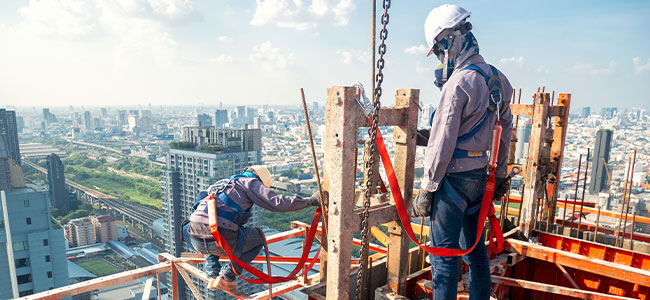
Supporting Your Team: 6 Tips for Recovery and Adjustment After a Suspension Trauma Incident
When an incident happens, a quick response plan is the key to minimizing the downsides of suspension trauma.
- By Mia Barnes
- Jan 22, 2024
There's always the risk of suspension trauma for those whose work involves heights and safety harnesses. When an incident happens, a quick response plan is the key to minimizing the downsides. It’s a leader’s responsibility to ensure the affected team member can return to their job promptly after being rescued. Learn some valuable tips on how to do so.
Signs of Suspension Trauma
Part of the rescue plan and the role of a safety manager is recognizing the signs of suspension trauma. Some of them are observable, making it apparent when a worker is having a problem. Then take appropriate action to address the issue. Look for these presyncope symptoms:
- Light-headedness
- Weakness
- Fatigue
- Dizziness
- Excessive sweating
- Nausea
- Changes in vision
- Numbness in the extremities
These symptoms can cause fainting in as little as seven minutes of being suspended. The longer they stay in the air, the higher the risk of serious injury. So an immediate response is critical.
Serious Consequences of Disrupted Circulation
The pressure of the safety harness on the legs can inhibit blood circulation in three major points: the legs, heart and brain. This disruption can lead to venous pooling, which occurs when the blood accumulates in the lower extremities and damages the muscle tissue, kidney and other vital organs. Moreover, the heart can go into shock and extreme anxiety, subsequently affecting the blood delivered to the brain.
Recovery Tips After an Incident
After the rescue, safety managers must provide physical and mental support so the worker can rapidly return to normal health. Here are some tips.
1. Convince Them to Seek Medical Attention
Suspension trauma cases should be treated like any other kind of traumatic injury. So seeking medical attention is a priority. Even if they were taken down promptly, encourage the worker to consult a health care professional if they refuse to see one. This way, they can be assessed for potential complications and receive immediate treatment.
2. Ensure They Follow the Physician’s Medical Order
The doctor may ask the worker to enroll in rehab therapy to restore muscle function and flexibility in the affected limbs, depending on the severity of the outcome. Ensure they follow through with them so that the incident doesn’t result in permanent injury.
3. Refer Them to a Mental Health Professional
Occupational accidents are closely associated with PTSD and increased risk of physical and psychological health impairment. The health implications for the suspended worker can be overwhelming. Being asked to stop working so that they can heal their injuries can lead to excessive stress over their job and relationships.
Get a referral to a mental health expert who specializes in trauma or post-traumatic stress disorder. Therapy and counseling can help the crew member overcome the psychological impact of the stressful incident.
4. Maintain a Supportive Environment
Empower them to voice their emotions and concerns by creating an environment that allows them to do so comfortably. Maintain open communication so that you can help address any anxieties they may have, especially related to their job. Additionally, doing little things like visiting or calling them a few days after the injury, sending them a get-well card and assuring them they can return to work can dispel unnecessary worries.
5. Encourage Self-Care
Suggest self-care by ensuring they comply with positive lifestyle practices to accelerate their recovery, such as eating healthy, engaging in physical activities and getting adequate relaxation. Staff can regain their health quickly if they couple medical interventions with better lifestyle choices.
6. Gradually Reintegrate the Worker
When the team member recovers enough to return to work, adjust their responsibilities to accommodate their existing ability and recovery process. Avoid giving them tasks that involve heights right off the bat. Instead, allow them time to relearn the ropes until they’re confident enough to do their previous jobs.
Additional Tips
Prevention is always better than a cure. Here are some tips to avoid or reduce incidences of suspension trauma in your organization:
- Increase awareness of suspension trauma prevention by providing ongoing training and education.
- Conduct debriefing sessions to identify actions or responses that could have prevented the incident, along with other areas for improvement.
- Prioritize the well-being of the crew by strictly implementing the use of various safety equipment on the site.
- Develop a clear and comprehensive emergency response plan and ensure all team members are familiar with it and know what to do when it happens.
Support the Team After an Incident
While the responsibility to oversee workers’ safety and well-being falls on these leaders, accidents can happen regardless of how careful the team is. If the team is affected, support the affected worker in all ways possible. Encourage them to seek treatment and adhere to a healthy lifestyle to recover quickly.
The employees are the lifeline of the business. Ensuring they feel supported through thick and thin will make workers feel appreciated.